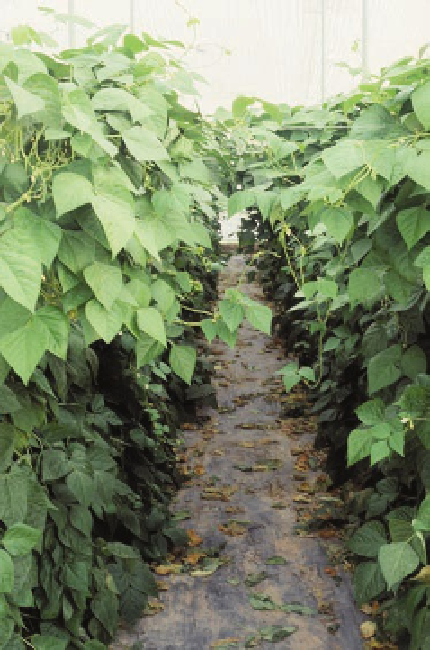Agriculture Reference
In-Depth Information
to avoid the incidence of polluting gases
(Hand, 1990).
The ambient humidity has little effect
on crop growth and development if certain
values of VPD are not exceeded. In condi-
tions in Northern Europe this level is 1 kPa
(Grange and Hand, 1987), whereas in
Mediterranean conditions the VPD may
reach 3 kPa as there is a certain adaptation
to unfavourable conditions (Lorenzo
et al
.,
1997b). High humidity values favour leaf
expansion, but may induce a deficit of cal-
cium in the leaf. In addition, it may promote
the development of diseases; if water con-
denses, fungal spores may germinate in the
water droplets formed. The large influence
of humidity on transpiration allows for the
manipulation of transpiration to avoid defi-
cits in nutrients, when transpiration is low
(Challa
et al
., 1995).
Other indicators used to characterize
growth are the growth rate of the main stem
and the leaf appearance rate. In unheated
Mediterranean greenhouses, in autumn-
winter cycles leaf appearance rates of 0.22
and 0.4 leaves day
−1
, for tomato and cucum-
ber, respectively, have been measured
(Castilla and Fereres, 1990; Castilla
et al
.,
1991), lower than those obtained under
optimal conditions. In a similar way, the
growth rate of the main stem reaches aver-
age values of 4.5 cm day
−1
in a trained
cucumber crop, for an autumn-winter cycle,
without heating, a value lower than 7.4 cm
day
−1
reported
for
optimal
conditions
(Castilla
et al
., 1991).
Another index widely used to charac-
terize growth is the LAI (leaf area index)
that quantifies the surface of leaves per unit
ground area (Photo 6.1).
Other growth indexes are detailed in
Appendix 1.
6.7.3
Growth analysis
The dry weight (or biomass) of a plant or of
a particular organ of a plant (and its evolu-
tion over time) is the parameter commonly
used to quantify growth.
The crop growth rate (CGR, expressed
in g m
−2
s
−1
) or net CGR or the accumula-
tion of dry matter quantifies biomass pro-
duction per ground area in a given unit of
time. Sometimes, it is called the dry
matter or biomass accumulation rate. In
unheated Mediterranean greenhouses,
average values of dry matter accumulation
of 6.5 g m
−2
s
−1
in tomato, which may be as
high as 9.5 g m
−2
s
−1
(values close to those
obtained in climatized greenhouses) when
climate conditions are favourable, have
been documented (Castilla and Fereres,
1990). In cucumber production without
heating, in an autumn-winter cycle, the
biomass accumulation rates are of the
order of 5.0 g m
−2
s
−1
, whereas values
obtained in greenhouses with climate
control in the spring cycle are around
9.9 g m
−2
s
−1
(Castilla
et al
., 1991). In a win-
ter melon crop without heating average
values of 9.7 g m
−2
s
−1
have been obtained,
in a late cycle (Castilla
et al
., 1996).
Photo 6.1.
A good leaf development allows for a
better interception of solar radiation. The plant
density must be adapted for this objective.

